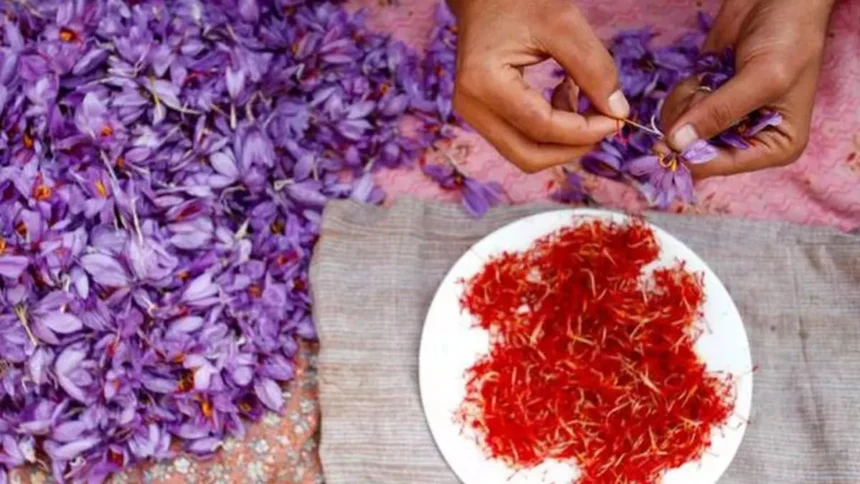Main Points In Hindi (मुख्य बातें – हिंदी में)
यहां दिए गए लेख के मुख्य बिंदु निम्नलिखित हैं:
-
तस्करी से रोकथाम: अगस्त 2023 में, कृषि विभाग की प्रवर्तन शाखा ने श्रीनगर हवाई अड्डे से 200 किलोग्राम केसर के फूलों की खेप जब्त की, जिससे घाटी से केसर की तस्करी को रोका जा सका है।
-
स्थानीय उत्पादन पर असर: केसर के बीजों की तस्करी, विशेषकर पंपोर क्षेत्र में, स्थानीय उत्पादन और केसर की घटती भूमि पर नकारात्मक प्रभाव डाल रही है।
-
प्रमाणिकता का खतरा: तस्करी कश्मीरी केसर की प्रामाणिकता को खतरे में डाल रही है, जिससे उपभोक्ता गलत जानकारी के आधार पर उत्पाद खरीद रहे हैं।
-
सरकारी कार्रवाई: सरकार ने 2023 में कॉर्म के अवैध निर्यात पर पूर्ण प्रतिबंध लगाया, जिसका उद्देश्य कश्मीरी केसर की रक्षा और पुनरुद्धार करना है।
- कृषि विकास परियोजना: 2023 में, सरकार ने 146 करोड़ रुपये की परियोजना को मंजूरी दी है, जिसका उद्देश्य जम्मू और कश्मीर में केसर की खेती को बढ़ावा देना है, जिसमें 290 हेक्टेयर भूमि को शामिल किया जाएगा।
Main Points In English(मुख्य बातें – अंग्रेज़ी में)
Here are the main points of the article regarding the Kashmiri saffron situation:


-
Seizure of Illegal Saffron Shipment: In August 2023, the Agricultural Department’s enforcement team seized a cargo of 200 kilograms of saffron flowers at Srinagar Airport, preventing their illegal export from the region.
-
Impact of Smuggling on Local Production: The smuggling of saffron seeds, especially from the Pampore region, is adversely affecting local saffron production due to reduced land area and declining cultivation practices.
-
Threat to Authenticity and Biodiversity: Smuggling poses a risk to the authenticity of Kashmiri saffron, misleading consumers about its origin and leading to the erosion of native saffron varieties, which could have long-term effects on biodiversity.
-
Government Interventions: The government has banned unauthorized exports of saffron corms under the Saffron Act of 2007 and the Seeds Act of 1996, which has effectively curbed smuggling and improved saffron cultivation conditions.
- Revitalization Efforts: Initiatives are in place to revitalize saffron farming, with a project approved to promote specific crops and a focus on bringing additional land under saffron cultivation, as evidenced by successful restoration in Pampore.
Complete News In Hindi(पूरी खबर – हिंदी में)
अगस्त 2023 में, कृषि विभाग की प्रवर्तन शाखा की एक टीम ने श्रीनगर हवाई अड्डे से 200 किलोग्राम केसर के फूलों की एक खेप जब्त कर ली, जिससे इसे एयर कार्गो के माध्यम से घाटी से बाहर तस्करी होने से रोका जा सके।
जम्मू-कश्मीर के बाहर केसर के बीजों की तस्करी, विशेष रूप से घाटी के प्रमुख केसर उत्पादक क्षेत्रों में से एक, पंपोर क्षेत्र में, केसर की घटती भूमि के बीच स्थानीय उत्पादन पर काफी प्रभाव डाल रही है।
भूमि की उर्वरता बनाए रखने या फसल के प्रसार के लिए बीज – केसर कॉर्म – 4 से 6 वर्षों के बाद खेतों से निकाले जाते हैं। कुछ किसान कॉर्म बेचते हैं, जो कभी-कभी, बाद में क्षेत्र से बाहर तस्करी कर ले जाया जाता है, जिससे क्षेत्र में बीज की कमी हो जाती है।
तस्करी से कश्मीरी केसर की प्रामाणिकता को भी खतरा है और उपभोक्ताओं को उनके द्वारा खरीदे जाने वाले केसर की उत्पत्ति के बारे में गुमराह किया जाता है।
कृषि निदेशक कश्मीर चौधरी मोहम्मद इकबाल ने बताया व्यवसाय लाइन तस्करी के कारण देशी केसर किस्म का क्षरण हुआ जिसके दीर्घकालिक परिणाम जैव विविधता पर पड़े।
चौधरी ने कहा, “इससे उन क्षेत्रों में केसर की घटिया खेती भी हो सकती है जहां इसकी तस्करी की जा रही है।”
हालाँकि, सरकार ने केसर अधिनियम 2007 और बीज अधिनियम 1996 के तहत 2023 में जम्मू और कश्मीर के बाहर कॉर्म के अवैध निर्यात पर पूर्ण प्रतिबंध लगा दिया।
कृषि विभाग के एक वरिष्ठ अधिकारी ने कहा कि प्रतिबंध को सख्ती से लागू करने से कॉर्म्स की तस्करी पर प्रभावी ढंग से रोक लगी है।
अधिकारी ने कहा कि इससे केसर भूमि के बड़े हिस्से के कायाकल्प में भी मदद मिली।
आधिकारिक आंकड़ों से पता चलता है कि पंपोर क्षेत्र में 217 कनाल से अधिक केसर का पुनरुद्धार किया गया है, जो पूरे भारत में प्रथम श्रेणी के केसर के उत्पादन के लिए जाना जाता है।
चौधरी ने कहा, “हमने प्रतिबंध के ठोस परिणाम देखे हैं क्योंकि केसर की खेती करने वालों को अब बीज आसानी से उपलब्ध हो गए हैं।”
केसर के खेत सिकुड़ रहे हैं और विशिष्ट फसलों को बढ़ावा मिल रहा है
पिछले कुछ वर्षों में, बदलते मौसम के मिजाज ने क्षेत्र में केसर उत्पादन पर असर डाला है। आधिकारिक आंकड़ों के अनुसार, पिछले दो दशकों में केसर उत्पादन में 65 प्रतिशत की गिरावट आई है, जबकि मसाले की खेती के लिए इस्तेमाल की जाने वाली भूमि 1996-97 में 5,707 हेक्टेयर से घटकर 2019-2020 में 2,387.1 हेक्टेयर हो गई है।
हालाँकि, 2023 में, सरकार ने समग्र कृषि विकास कार्यक्रम के तहत जम्मू और कश्मीर की विशिष्ट कृषि विरासत के हिस्से के रूप में विशिष्ट फसलों को बढ़ावा देने के लिए ₹146 करोड़ की एक परियोजना को मंजूरी दी।
कृषि निदेशक के अनुसार, 290 हेक्टेयर भूमि को केसर की खेती के तहत लाया जाना है।
उन्होंने कहा, “यह परियोजना ऐसी फसलों को भारी बढ़ावा देने वाली है।”
Complete News In English(पूरी खबर – अंग्रेज़ी में)
In August 2023, a team from the agriculture department’s enforcement branch seized a shipment of 200 kilograms of saffron flowers at the Srinagar airport, preventing it from being smuggled out of the valley via air cargo. The smuggling of saffron seeds, especially from Pampore, a major saffron-producing area in Kashmir, is significantly affecting local production amid decreasing land available for saffron cultivation.


Saffron bulbs, known as corms, are harvested from fields after 4 to 6 years to maintain soil fertility or to propagate crops. Some farmers sell these corms, and they are sometimes smuggled out of the region, leading to a shortage of seeds locally. This smuggling also threatens the authenticity of Kashmiri saffron and misleads consumers about the origin of the saffron they buy.
Choudhary Mohammad Iqbal, the agriculture director of Kashmir, reported to Business Line that smuggling has led to a decline in native saffron varieties, which has long-term biodiversity consequences. He added that this could result in poorer saffron farming in areas where smuggling occurs.
However, in 2023, the government imposed a complete ban on the illegal export of corms outside Jammu and Kashmir under the Saffron Act of 2007 and the Seed Act of 1996. A senior officer from the agriculture department noted that strict enforcement of this ban has effectively reduced smuggling. This has also contributed to the revitalization of saffron land.
According to official data, over 217 kanals (a unit of land area) of saffron have been revitalized in the Pampore area, known for producing high-quality saffron in India. Iqbal mentioned that the results of the ban have been significant, with saffron growers now having easier access to seeds.
Saffron Farms Shrinking While Other Crops Gain Ground
In recent years, changing weather patterns have impacted saffron production in the region. Official figures indicate a 65% decline in saffron production over the past two decades, with the land used for saffron cultivation shrinking from 5,707 hectares in 1996-97 to 2,387.1 hectares in 2019-2020.
In response, the government approved a ₹146 crore project in 2023 to promote specific crops as part of a broader agricultural development program in Jammu and Kashmir. The agriculture director stated that 290 hectares of land will be brought under saffron cultivation, emphasizing that this initiative will significantly support these crops.




